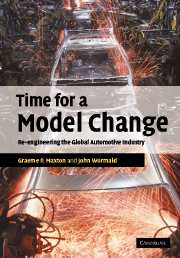Book contents
- Frontmatter
- Contents
- List of figures
- Foreword by G. Fredric Bolling
- Acknowledgements
- Glossary
- Introduction
- 1 From automania to maturity – in the main markets at least
- 2 The problems that can be fixed – dealing with noxious emissions, traffic accidents and congestion
- 3 The global resource challenges – energy and global warming
- 4 A global industry and the changing international order
- 5 The supplier industry – the catalyst for the profound changes to come?
- 6 The downstream sales and service sector
- 7 When the labels do not add up
- 8 Choosing a future for the automotive industry
- 9 Time for a model change
- Index
1 - From automania to maturity – in the main markets at least
Published online by Cambridge University Press: 22 September 2009
- Frontmatter
- Contents
- List of figures
- Foreword by G. Fredric Bolling
- Acknowledgements
- Glossary
- Introduction
- 1 From automania to maturity – in the main markets at least
- 2 The problems that can be fixed – dealing with noxious emissions, traffic accidents and congestion
- 3 The global resource challenges – energy and global warming
- 4 A global industry and the changing international order
- 5 The supplier industry – the catalyst for the profound changes to come?
- 6 The downstream sales and service sector
- 7 When the labels do not add up
- 8 Choosing a future for the automotive industry
- 9 Time for a model change
- Index
Summary
Out of gas – and nowhere else to go
In the time it takes you to count to five, ten new cars and trucks will have been built and sold somewhere across the world: all day, every week, throughout the year. In the same time, almost as many vehicles will have been wrecked beyond repair or scrapped and hundreds will have been damaged in other ways. In the next 15 minutes, thirty-four people will have been killed as a result of motor vehicle accidents. Hundreds will have been hospitalised.
The automotive industry works on a scale so awesome and has an influence so vast that it is often difficult to see. Roughly a million new cars and trucks are built around the world each week – they are easily the most complex products of their kind to be mass-produced in such volumes. The industry uses manufacturing technology that is at the cutting edge of science. It uses 15 per cent of the world's steel, 40 per cent of the world's rubber and 25 per cent of the world's glass. The vehicles themselves, these emotive icons of success, use a staggering 40 per cent of the world's annual oil output.
The motor industry is the world's largest single manufacturing activity. In 2002, the industry's most recent peak, it produced almost 58 million vehicles worldwide. Each contained up to 8,000 individual parts of widely varying materials, made in highly specialised factories across the world.
- Type
- Chapter
- Information
- Time for a Model ChangeRe-engineering the Global Automotive Industry, pp. 3 - 30Publisher: Cambridge University PressPrint publication year: 2004



